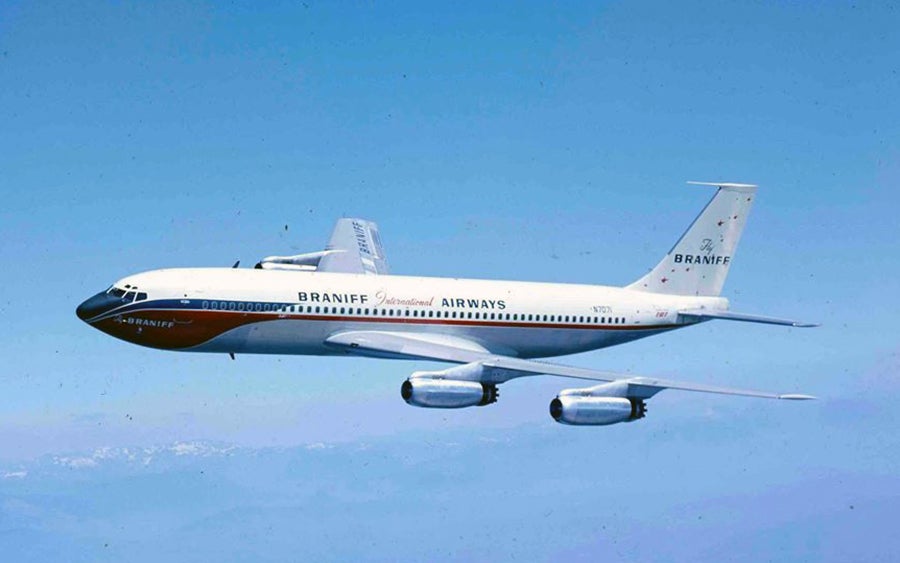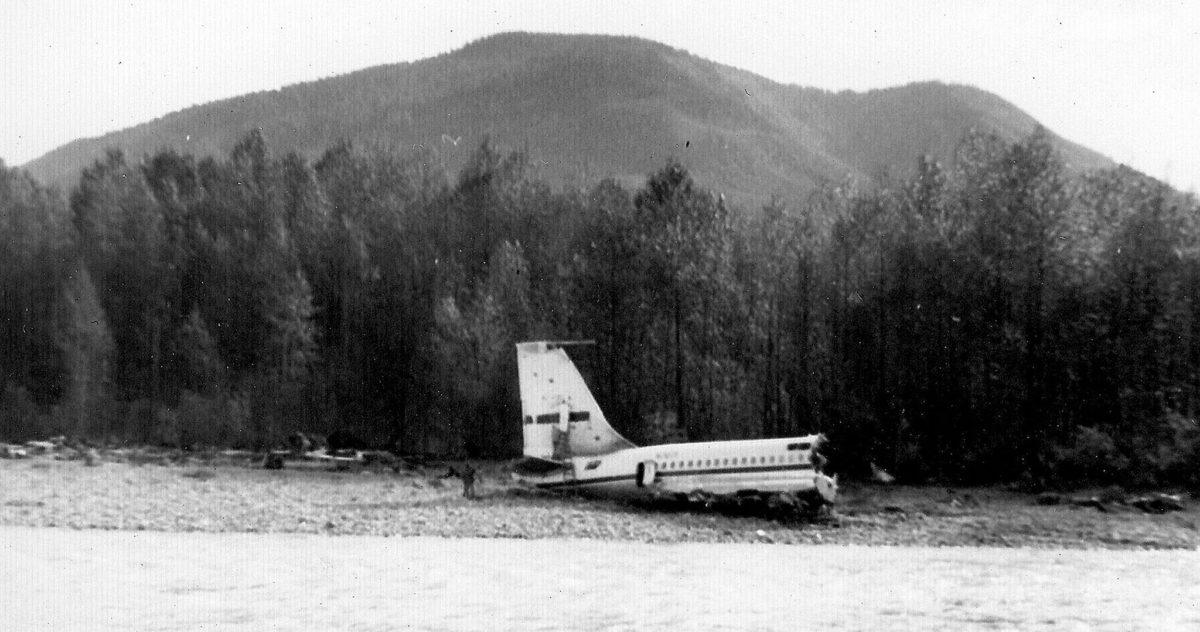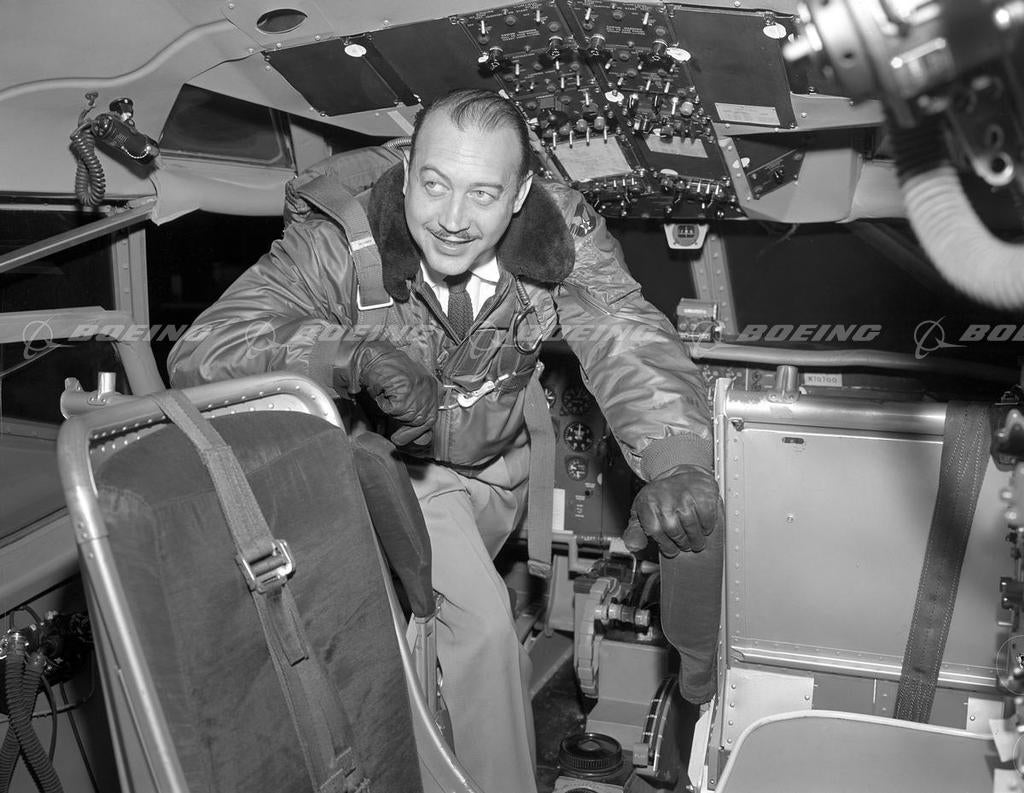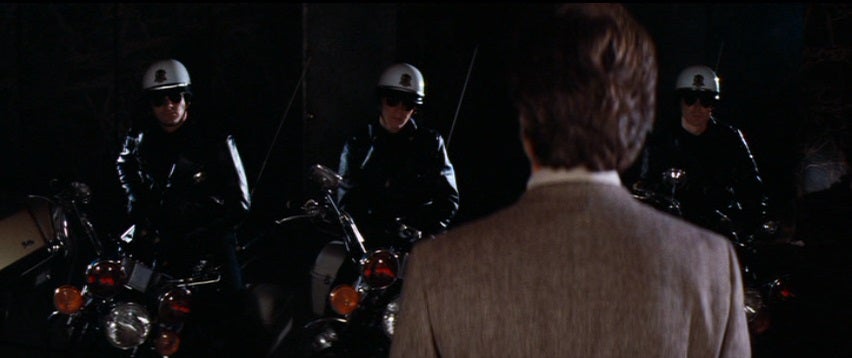 "ttyymmnn" (ttyymmnn)
"ttyymmnn" (ttyymmnn)
08/08/2018 at 12:35 ē Filed to: wingspan, Planelopnik
 4
4
 19
19
 "ttyymmnn" (ttyymmnn)
"ttyymmnn" (ttyymmnn)
08/08/2018 at 12:35 ē Filed to: wingspan, Planelopnik |  4 4
|  19 19 |
In the movie Magnum Force , Dirty Harry famously said, ďA manís got to know his limitations.Ē Pilots have to know their limitations as well, both of their piloting skill and of the airplane itself, because exceeding those limits can have tragic results.

Braniff El Dorado Super Jet 707 N7071 in the skies over Washington.
In 1955, Braniff ordered five 707s from Boeing, the first all-jet airliners to be flown by the company. But these werenít everyday 707s. They were nicknamed the El Dorado Super Jet (707-227) and had more powerful !!!error: Indecipherable SUB-paragraph formatting!!! engines. Braniff planned to use the aircraft on their South American routes, where the engines would be suited to high altitude and hot air.
The first of these Super Jets, N7071, took its maiden flight on June 11, 1959 and was then flown on a series of training and familiarization flights with Boeing instructors and Braniff personnel. During a training flight on October 19, 1959, the Boeing pilot was putting the 707 through its paces and was working with a new Braniff pilot on his first flight in the 707. The pilots were working specifically on recovery from a !!!error: Indecipherable SUB-paragraph formatting!!! , a phenomenon to which the swept-wing 707 was particularly susceptible. Boeing had stated that the limit for a safe Dutch roll was 25-degrees of bank, but the Boeing pilot put the 707 into a roll of 45-degrees, and perhaps as much as 60-degrees. The Braniff pilot tried to recover, only to have the plane snap back in the other direction to 90-degrees of roll. The stresses on the wings caused the number 1, 2 and 4 engines to shear off the pylons, and fire engulfed the left wing.
 !!!CAPTION ERROR: MAY BE MULTI-LINE OR CONTAIN LINK!!!
!!!CAPTION ERROR: MAY BE MULTI-LINE OR CONTAIN LINK!!!
The Boeing pilot managed to regain control and attempted a crash landing beside the Stillaguamish River north of Boeingís Everett, Washington factory. The four Braniff and Boeing employees along for the ride hastily moved to the rear of the aircraft while the Boeing pilots aimed for flat ground beside the river. After cutting the one remaining engine to level the plane out, the 707 struck trees short of the landing area. The crash claimed the life of the two Braniff pilots, the Boeing instructor, and the Boeing engineer in the cockpit. The four passengers survived in the mostly-intact tail section. The !!!error: Indecipherable SUB-paragraph formatting!!! by the Civil Aeronautics Board faulted the Boeing pilot for rolling beyond the design limits of the aircraft, and also for trying to teach the recovery maneuver to a first-time pilot. The cost of the crashed aircraft was paid by Boeing.
(For more about this flight, see !!!error: Indecipherable SUB-paragraph formatting!!! on Facebook)
!!! UNKNOWN CONTENT TYPE !!!
For more stories about aviation, aviation history, aviators and airplane oddities, visit
!!!error: Indecipherable SUB-paragraph formatting!!!
.
!!! UNKNOWN CONTENT TYPE !!!
 RamblinRover Luxury-Yacht
> ttyymmnn
RamblinRover Luxury-Yacht
> ttyymmnn
08/08/2018 at 12:47 |
|
Donít mind me, posting the intro with Lalo Schifrin theme...
 Just Jeepin'
> ttyymmnn
Just Jeepin'
> ttyymmnn
08/08/2018 at 12:50 |
|
Iím reminded of my momís decision to teach me how to drive stick by changing with me on a major road running through a city (Kokomo) which was notorious for its many stoplights. Not in a parking lot, not on a back road, but throwing me into the deep end.
Stalled out at 2 consecutive stoplights before I convinced her to take control back.
( Obviously not quite the same.)
 ttyymmnn
> RamblinRover Luxury-Yacht
ttyymmnn
> RamblinRover Luxury-Yacht
08/08/2018 at 12:53 |
|
Donít mind at all. I use that line a lot. And it doesnít necessarily mean something bad. I believe that it means that it is equally important to learn what you are not good at as it is to learn what you are good at.
Iím reading the book series The Chronicles of Prydain by Lloyd Alexander to my middle-schoolers. We are just about to start the fourth book, Taran Wanderer , where the hero, who is about 16 or 17 years old, goes in search of his parents and, ultimately, for himself . Along the way, he tries various trades, only to discover that he really isnít very good at any of them. Only through this process of trial and error does he finally discover what he is good at. Itís a fantastic series, and Iím thrilled to be going through them again. For me, the books were my gateway drug to Tolkien.
 ttyymmnn
> RamblinRover Luxury-Yacht
ttyymmnn
> RamblinRover Luxury-Yacht
08/08/2018 at 12:54 |
|
Also, that music is fantastic.
 RamblinRover Luxury-Yacht
> ttyymmnn
RamblinRover Luxury-Yacht
> ttyymmnn
08/08/2018 at 12:55 |
|
I reread The Book of Three several months ago, but didnít progress in a series reread because I donít know where our copy of The Black Cauldron is...
 ttyymmnn
> Just Jeepin'
ttyymmnn
> Just Jeepin'
08/08/2018 at 12:56 |
|
No, but there is a time and a place for sink or swim.
 For Sweden
> ttyymmnn
For Sweden
> ttyymmnn
08/08/2018 at 12:58 |
|
Hotdoggers...
 ttyymmnn
> RamblinRover Luxury-Yacht
ttyymmnn
> RamblinRover Luxury-Yacht
08/08/2018 at 12:59 |
|
Itís still in print. I read them again as an adult a few years ago and was thoroughly engrossed, even though I know what happens. Alexander is a fantastic writer for adolescents, and the lessons he teaches about honesty and loyalty and being true to your word are vitally important.
 ttyymmnn
> For Sweden
ttyymmnn
> For Sweden
08/08/2018 at 13:00 |
|

Knows a thing or two about hotdogging a 707.
 RamblinRover Luxury-Yacht
> ttyymmnn
RamblinRover Luxury-Yacht
> ttyymmnn
08/08/2018 at 13:49 |
|
I need to give it a whirl on my bass.
 TheRealBicycleBuck
> ttyymmnn
TheRealBicycleBuck
> ttyymmnn
08/08/2018 at 16:26 |
|
We were just talking about stall and roll recovery in ground school on Monday night. Private pilots are required to practice stalls and recovery. Commercial pilots are required to practice recognizing early stall conditions and recovering. They are not required to practice stalls in commercial aircraft anymore.
 ttyymmnn
> TheRealBicycleBuck
ttyymmnn
> TheRealBicycleBuck
08/08/2018 at 16:30 |
|
They are not required to practice stalls in commercial aircraft anymore.
Hmm. Air France 447 . But I would think that a modern computer-controlled and monitored airliner shouldnít get into a stall in the first place. The Dutch roll was a known issue with the 707, and they had to turn off the yaw dampers to get it into that state. Iím not sure what the Boeing pilot was thinking. Either the plane got away from him, or he was trying to be a badass. Either way, he died.
 ttyymmnn
> TheRealBicycleBuck
ttyymmnn
> TheRealBicycleBuck
08/08/2018 at 16:30 |
|
They are not required to practice stalls in commercial aircraft anymore.
Hmm. Air France 447 . But I would think that a modern computer-controlled and monitored airliner shouldnít get into a stall in the first place. The Dutch roll was a known issue with the 707, and they had to turn off the yaw dampers to get it into that state. Iím not sure what the Boeing pilot was thinking. Either the plane got away from him, or he was trying to be a badass. Either way, he died.
 TheRealBicycleBuck
> ttyymmnn
TheRealBicycleBuck
> ttyymmnn
08/08/2018 at 16:59 |
|
A modern plane shouldnít, but equipment failures can cause major problems. In Air France 447, the original failure appears to have been a blocked pitot tube. Without that, the plane loses its primary source of airspeed information. Once that was lost, then the autopilot disconnected, the pilots misinterpreted what was going on and reacted incorrectly, causing the crash. With a fully glass cockpit, airspeed can come from other sources and itís less likely they will get erroneous data. In other words, itís less likely to happen because of additional redundant systems.
 ttyymmnn
> TheRealBicycleBuck
ttyymmnn
> TheRealBicycleBuck
08/08/2018 at 17:03 |
|
AF447 was a cock up of epic proportions. I still believe that one of the major contributing factors was the fact that the pilot joysticks in the Airbus are not linked together. Based on the incorrect speed data, one of the pilots had the stick all the way back. But the other pilot had no idea what the first was doing. Now, Iím nowhere near being a pilot, and Iíve actually had an internet conversation with an A320 pilot who likes the joystick. But it seems to me that if you are going to be driving what is essentially a flying bus, you should have a proper wheel in front of you, and one that mirrors the movements for both pilots.†
 TheRealBicycleBuck
> ttyymmnn
TheRealBicycleBuck
> ttyymmnn
08/08/2018 at 17:15 |
|
Our instructor was talking about a near-crash that had a similar root cause. There was some kind of fault in the system. While the Captain was trying to troubleshoot the problem, t he first officer was trying to fly the plane, but the plane wasnít responding. The plane was getting farther and farther out of sorts, but b efore they crashed, the pilot realized he was putting pressure on his joystick, e ffectively disabling the co-pilotís joystick. Onc e the pilot got his hand off of it, the co-pilot was able to straighten out the plane.
So, I agree with you - a fully linked system which provides haptic or force feedback should be a requirement for all designs, whether itís a yoke or a joystick.
 shop-teacher
> ttyymmnn
shop-teacher
> ttyymmnn
08/08/2018 at 17:26 |
|
I need to watch that movie again. I use that line all the time.
 ttyymmnn
> shop-teacher
ttyymmnn
> shop-teacher
08/08/2018 at 17:35 |
|
It was just on TV the other night. Itís good, but I still think the first one is better.

 shop-teacher
> ttyymmnn
shop-teacher
> ttyymmnn
08/08/2018 at 18:04 |
|
The first one is definitely better, but Magnum Force and The Enforcer are both really good as well.
Sudden Impact is horrible. I enjoyed the novelty of the remote control Corvette Stingray bombs in Dead Pool, but it's not a good movie.